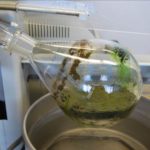Environmental matrices

As the national metrology laboratory in the field of ionizing radiation and because of its forty years of experience in organizing interlaboratory tests, the LNHB was asked by laboratories participating in IRSN’s regulatory tests to organise preparation tests.
Since 2003, ASN and IRSN have had the mission of leading and managing the Réseau National de Mesures (National Network of Measures (RNM) instituted by articles R. 1333-11 and R. 1333-11-1 of the Public Health Code). Radiological analyses of environmental samples are therefore carried out by IRSN and approved laboratories.
Approvals are granted on the basis of quality and technical criteria: in particular, if satisfactory results are obtained in the multiannual intercomparison tests organised by IRSN. The various interlaboratory tests are programmed by type of environmental matrix and by category of radioactive measurement according to the accreditation grid approved by the ASN. There are thus 6 families of environmental matrices (water, soil, biological matrices, aerosols, etc.) and 17 categories of radioactive measurements (tritium, alpha global, beta global, radionuclides emitting γ radiation > 100 keV, etc.), representing 52 approvals. The results of the tests are analyzed by an approval committee. A deviation of more than 25% from the reference values shall result in withdrawal of approval. It was therefore important to allow approved laboratories to test and improve their performance prior to regulatory testing.
The LNE-LNHB has therefore equipped itself with various background low-noise measuring facilities, as well as two laboratories fitted out and equipped (ventilation, laboratory furniture, equipment) to prepare liquid or solid environmental matrices (e.g. soils or plants): a laboratory for preparing and processing samples and a room dedicated to the grinding of solid matrices.


For liquid matrices, methods for separating and measuring radionuclides with established radiochemical separation steps allow the determination of reference values with their associated uncertainties.
For solid matrices, for which the preparation conditions are more specific, LNHB has the technical means to produce labelled environmental samples for various densities and compositions.
The determination of the reference values and associated uncertainties for this type of marked matrix is carried out according to the following process:

- sampling of a homogeneous matrix with radiological background noise measurement,
- drying: in order to facilitate the grinding stage and increase the shelf life of the matrix by decreasing its water content,
- crushing to obtain a finely divided matrix,
- sieving to characterize particle size distribution and recover the desired fraction,
- homogenisation: mixing of all processed batches and assessment of density and moisture content of the matrix,
- marking in wet environment,
- drying,
- gamma-ray spectrometry measurements in the case of gamma emitters to characterize the resulting marked matrix in terms of average mass activity and to estimate the yield of the marking process as well as the homogeneity of the prepared matrix.


For example, an interlaboratory test for the measurement of the plant matrix labeled with gamma-emitting radionuclides was organized by the LNE-LNHB with the identification of the radionuclides present and measurement of their mass activity, for an activity level of a few hundred mBq. g-1.
As part of these activities, the LNHB also participates in international intercomparison exercises conducted under the auspices of the CCRI or the IAEA, for example.
Example of collaborative projects:
MetroRWM (MetroRWM (Metrology for Radioactive Waste Management) with the measurement of clay beads, gravel and pozzolana,
MetroMetal (Ionizing radiation metrology for metallurgical industry) with the measurement of slag and ash,
IND57 MetroNORM (Metrology for processing materials with high natural radioactivity) with measurement of phosphogypsum, ion exchange resins
Our job: metrology
dosimetry
Implemented methods for the establishment of national references must be adapted to the radiation type and its intensity. They are based on measurement technics such as calorimetry, ionometry and chemical dosimetry.
Radioactivity
The variety of the emitted radiation and physical forms of the sources oblige to adapt the measurement process in order to establish national references: methods with defined geometries, or 4 π countings geometries, coincidence countings, etc.
